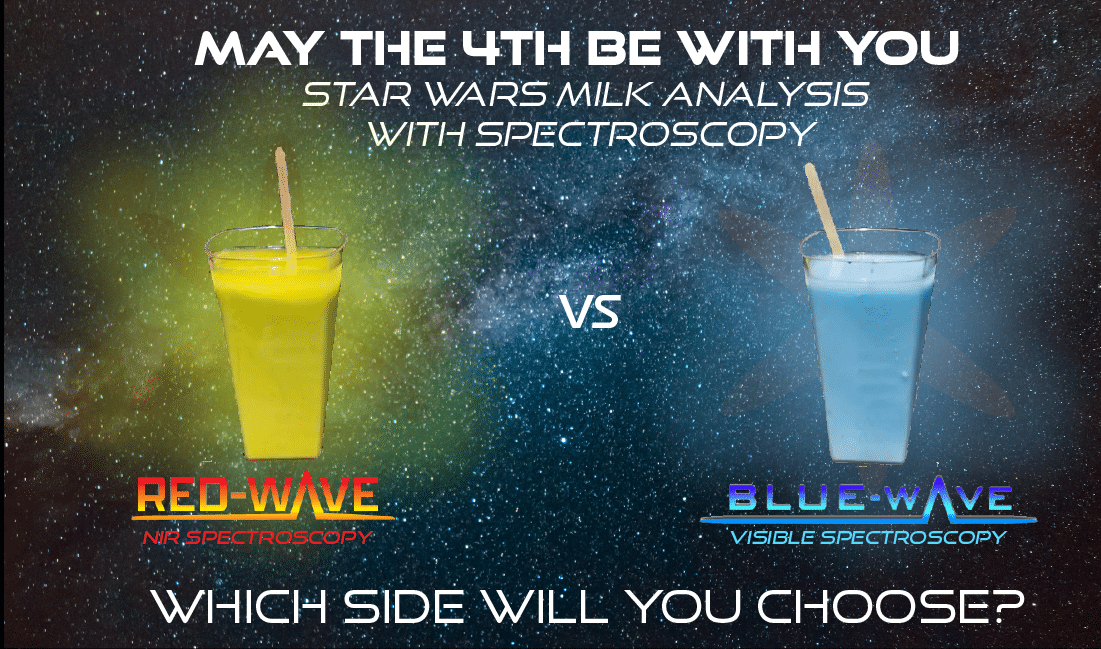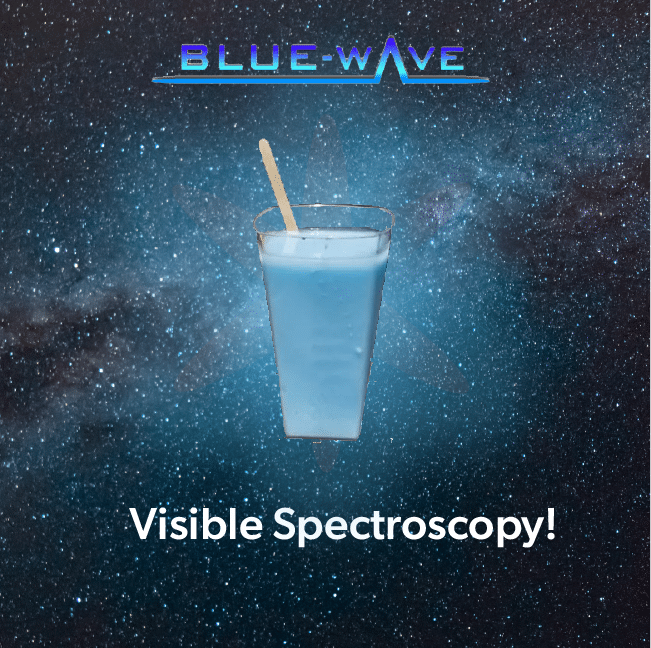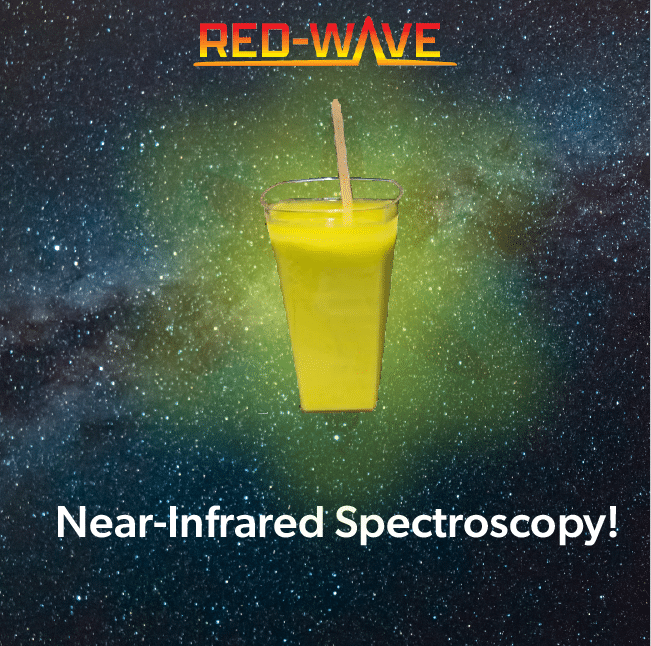
Looking to score some Blue or Green Milk from “a galaxy far, far, away?” Blue and green milk are fictional beverages that previously existed only in the Star Wars Universe. The famous blue milk first made its appearance in Episode IV: A New Hope as a byproduct of Tatooine’s banthas. Luke’s Aunt Beru, was seen pouring a non-descript blue milk from a jug in her kitchen and ever since that fateful scene, fans have been fascinated by this mysterious elixir. In The Last Jedi, fans witness Luke Skywalker milk a Thala Siren for its green milk. Now Disneyland and Disney World offer blue and green milk at their parks to celebrate Star Wars. If Disney or scientists from the planet Coruscant wanted to analyze the quality of these mythical milks, how would they do it? Both Visible and NIR spectroscopy can be used to differentiate between types of milk based on their chemical composition and optical properties. Visible and NIR spectroscopy are both techniques used to study the interaction of light with matter. In the case of milk, these techniques can be used to identify color and quantify its major components, such as water, proteins, fats, and lactose. Which side will you choose, Visible or NIR spectroscopy?

Visible Side – The Phantom Blue Menace
Visible Spectroscopy can be used to measure the color of milk, which is determined by the absorption and reflection of light by its constituents. For example, blue milk may absorb more red light and reflect more blue light than green milk, leading to a difference in their visible spectra. Using our ColorWiz handheld analyzer, you can measure the absorbance and reflectance of colors to collect their spectral reflectance and assure the quality of your blue milk product anywhere and anytime. Often, we use CIELAB L*a*b* values and a dE color difference to consistently measure the color of manufactured beverages and products. The “Visible Side” or visible spectroscopy is used by researchers and industrial applications to measure color differences we as humans can not even see! A dE of 3 is typically considered a different color, but humans often can only start to perceive differences around 7 to 10 dE units! The force is strong with visible spectroscopy 🙂
NIR Side – Revenge of the Green
NIR spectroscopy, on the other hand, can be used to measure the chemical composition of milk, including its protein, fat, and lactose content. Different types of milk have different ratios of these components, leading to differences in their NIR spectra. The ChemWiz-ADK allows you to easily identify the composition of your samples whether it’s green milk, sliced provolone, almond milk, or dairy powders. NIR spectroscopy detects molecular vibrations and quantifies those vibrations into component composition. Visible spectroscopy is strong, however, the force with the NIR side might be even stronger!

Which Side Will You Choose?
“Only a Sith deals in absolutes!” – Obi-Wan Kenobi, Episode III: Revenge of the Sith
Overall, visible and NIR spectroscopy are complementary techniques that are used for different types of analysis and applications. While visible spectroscopy is mainly used to analyze the electronic properties of molecules and characterize materials based on their color, NIR spectroscopy is used to analyze the vibrational properties of molecular bonds and determine the chemical composition of complex samples.

Visible Spectrometers
StellarNet visible spectrometers measure light beyond the visible range of 400 to 700nm and are used to analyze the electronic transitions of molecules, which result in the colors we see. Our Blue-Wave spectrometers are offered in a variety of rugged models that cover ranges from 200 – 1150nm (depending on the model). Visible spectroscopy is commonly used in fields such as biology, chemistry, and environmental science, where it is used to identify and quantify substances in solutions, measure the concentration of pigments, and characterize materials based on their color properties. Examples of applications of visible spectroscopy include analyzing the color of wines, measuring the concentration of a protein in a solution, and identifying the presence of metal ions in a sample.
NIR Spectrometers
In contrast, our NIR spectrometers detect light in the range of 900 to 2500 nm and are used to measure the vibrations of molecular bonds, which result in the absorption of light at specific wavelengths. StellarNet’s DWARF-Star, RED-Wave spectrometer, and ChemWiz-ADK NIR Analyzer are easy-to-use and portable tools that measure the NIR range. NIR spectroscopy is commonly used in fields such as agriculture, food science, nutraceuticals, and materials science, where it is used to analyze the composition of complex samples.

Examples of applications of NIR spectroscopy include analyzing the moisture content of grains, identifying the active ingredients in a drug formulation, and characterizing the chemical composition of plastics. One of the main advantages of NIR spectroscopy is that it is non-destructive, fast, and can be used to analyze samples in a variety of forms, such as powders, liquids, and solids.
Stellar Non-Alcoholic Blue Milk
If you’re looking to try blue milk at home, try our Stellar Blue Milk recipe! Even if you’re a non-dairy drinker, you can substitute whole milk with any of your choosing (almond, goat, oat). Celebrate Star Wars day with Bantha milk and a small bowl of cereal like Luke Skywalker.
Ingredients
1-1/2 cups milk
1 tablespoon sugar
½ teaspoon vanilla
½ teaspoon apricot syrup
marshmallow Fluff (optional)
blue food gel dye
Edible Silver Glitter
Mix together your milk, sugar, vanilla and apricot oil. Add 3 drops of blue food dye for a rich blue coloring then sprinkle in your desired amount of edible silver glitter. If you’re looking for added sweetness be sure to top of your blue milk with marshmallow fluff.
Adults looking to have a bit more fun?
StellarNet’s Green Milk
This is a fun twist on the Macadamia Nut Chi Chi originated with versions attributed to Polynesian forebears Don the Beachcomber and Trader Vic.
Ingredients
4 ounces Vodka (substitute Rum and this becomes a Macadamia Nut Piña Colada!)
2.5 ounces Trader Vic’s Macadamia Nut Liqueur
1 ounce Midori (this is where we get the green)
8 ounces unsweetened pineapple juice
2 ounces coconut cream (Coco Lopez)
1 cherry (garnish)
1 wedge of Pinapple (garnish)
Mix vodka, liqueur, Midori, pineapple juice, and coconut cream. Add 2 cups crushed ice and blend until creamy. If you don’t have a blender, shake with crushed ice. Serve in a shapely clear glass to show off the color and garnish with a wedge of pineapple and a cherry. A pineapple leaf sticking out of the green milk adds extra panache! The Midori adds the green color – if you don’t have Midori, use green food coloring. Fresh pineapple juice is preferred to canned. Substitute 1 ounce Blue Curacao for the Midori and you’ve got a Blue Milk. This is the way!
MAY THE 4TH BE WITH YOU!!!
We hope you enjoyed our Star Wars Day spectroscopy post 
“Luminous beings we are, not this crude matter.” – Yoda Episode V: The Empire Strikes Back





